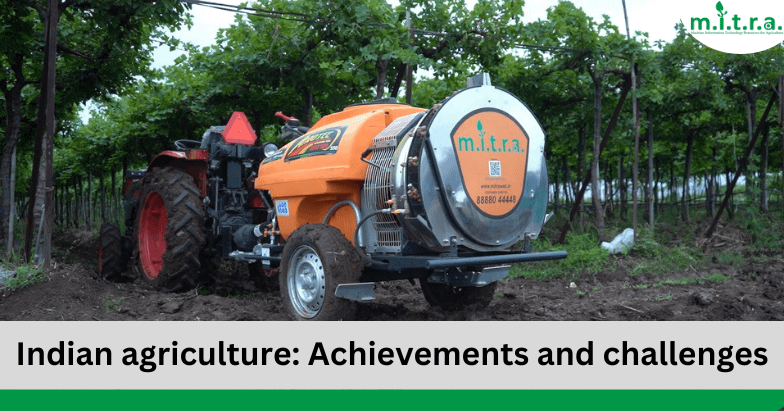Description
The new threats posed by next-generation technology require a second green revolution. According to the report, digital technology and extension services will boost information exchange and farmer awareness. The air assisted sprayer has been widely used for disease and pest management for decades due to its reputation as a highly effective pesticide application tool.
“Indian Agriculture: Achievements and Challenges” point out that despite the country’s improvement in output, ensuring food security, food inflation, and volatility remains a challenge, requiring supply-side intervention strategies, such as increasing public investment, extending storage resources, and developing food processing facilities. A low volume sprayer will allow farmers to achieve high yields.
RBI published “Indian Agriculture: Achievements and Challenges.”
Introduction
- India’s agriculture sector has risen to prominence due to the first Green Revolution.
- India now possesses the world’s giant cow herd and is the world leader in producing milk, lentils, jute, and spices (buffaloes). India is second in growing rice, wheat, cotton, sugarcane, tea, groundnuts, and fruits and vegetables.
- Although agriculture’s percentage of India’s total GVA has been falling, the sector has been expanding in absolute terms, and it now provides income for about half of the country’s households.
- Despite these advancements, climate change disruptions, fragmented landholdings, low agricultural productivity, and high food price volatility remain problems for Indian agriculture.
- India’s overproduction of rice, wheat, and sugarcane has led to fast groundwater depletion, soil degradation, and massive air pollution, raising issues about the sustainability of existing agricultural practices.
Achievements in Indian Farming
- Increases in quality seed and fertilizer use, irrigated land area, crop yields per acre, and cropping intensity have all contributed to record food grain production in recent years.
- Horticulture production has surpassed foodgrains production since 2012-13 and accounts for 35% of overall crop output in agriculture.
- A growing number of people, including small and marginal farmers and landless labourers, rely on livestock as a reliable source of income due to the progressive decline in operational land holdings.
- The agriculture sector’s proportion in international commerce of agricultural and allied sector products has increased from 1.1% in 2000 to 2.2% in 2018, demonstrating a shift in the industry’s dynamics. In 2020–21, agriculture and related industries accounted for 14.2% of India’s exports.
Factors Crucial to Agriculture’s Growth in India
Productivity Improvements: The use of high-yielding seed types, government funding for agricultural research, and fertilizer have all contributed to a dramatic increase in the output of food grains. While cereal production increased at a steady rate, that of pulses, oilseeds, Nutri-cereals, and horticulture crops lagged far behind. Also, Indian agriculture yields have historically been only approximately 30-60% of those in affluent nations.
The Mechanization of Farming: Mechanizing farms have the potential to boost yields by 30 per cent while cutting input costs by 20 per cent. Mechanized farming cuts down on the time needed to accomplish agricultural activities and eases the monotony that agriculture works. While Brazil and Russia both have mechanization rates of about 75%, affluent countries have rates much beyond 90%.
Irrigation Area Expanding: It’s possible to irrigate 126.7 million hectares. PMKSY enhanced micro irrigation (sprinkler and drip irrigation) to ensure farm water efficiency. The irrigated area in India is 34.4%, compared to 38.6% without irrigation. To protect crops from pests and diseases, farmers use an air blast sprayer, a machine designed to spray liquid, typically pesticides.
The Future and Its Challenges
Challenges
- The unpredictability of food prices increases
- Climate/weather and few resources
- Small landholdings.
- A deficiency in soil fertilization.
- Inadequate storage facilities and supply chain services include harvesting, packaging, and transporting.
- Overproduction of rice, wheat, and sugarcane has led to fast groundwater depletion, soil degradation, and massive air pollution, raising issues about the sustainability of existing agricultural methods in India. A tractor trailed sprayer is ideal for treating tall plants like mango, coconut, and date palms.
- India’s crop production is significantly lower than other developed and developing market economies for several reasons, including smaller farm sizes, less mechanization of farming, and fewer resources allocated to the sector overall.
Conclusion
Emerging markets for land consolidation and improvements in post-harvest procedures, as well as reviving the cooperative movement through the establishment of Farmer Producer Organisations, would all be necessary to effectively address these issues, making a second green revolution necessary (FPOs). The tractor mounted sprayer is the most popular sprayer, which has easy-to-use controls and well-engineered nozzle configurations for the targeted application of pesticides to crops. By doing so, we can reduce the uncertainty around food prices and farmer earnings and unlock the full potential of Indian agriculture. Mitra Agro Equipment has created a range of sprayers, including the Air Blast Sprayer, tractor-mounted sprayers, the Vineyard Sprayer, and the Duster.

